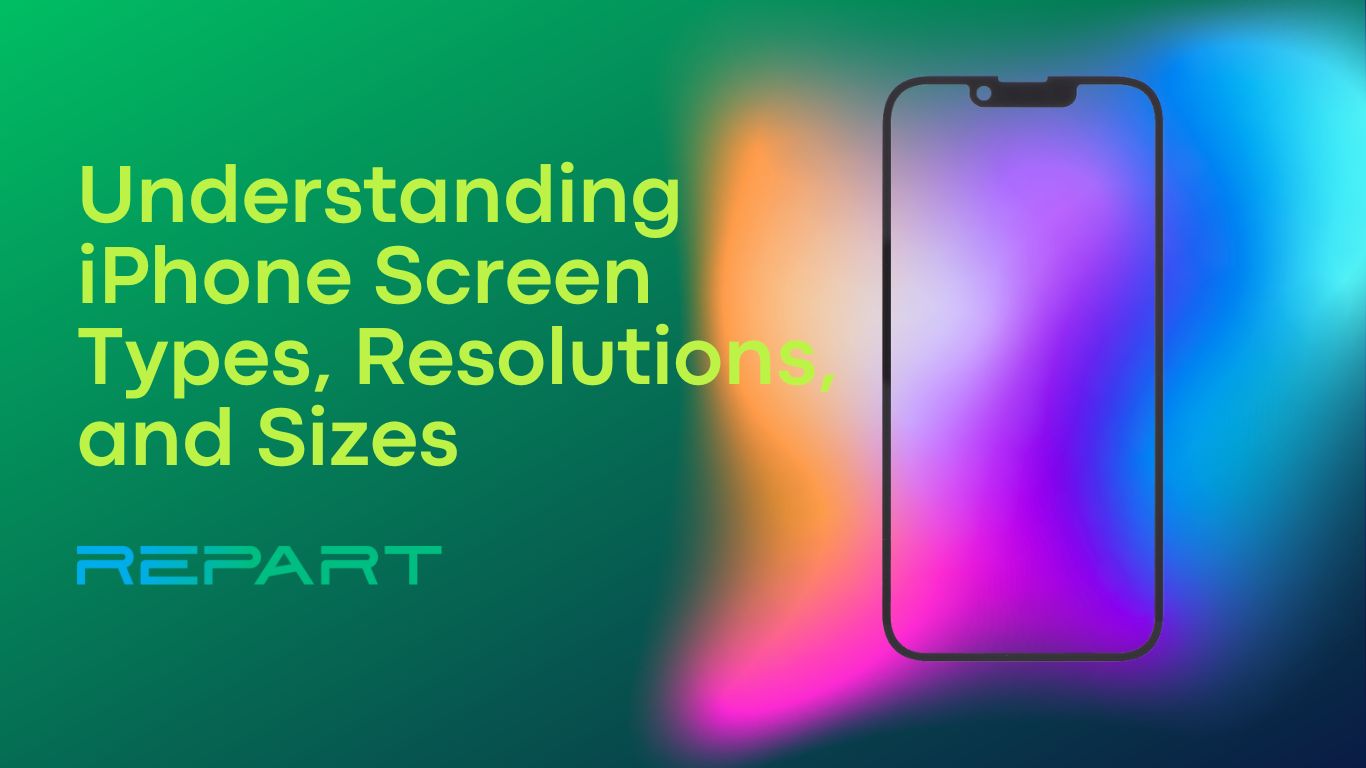Understanding iPhone Screen Types, Resolutions, and Sizes: A Complete Guide

As a tech enthusiast and iPhone user, you know that the screen is one of the most important factors to consider when choosing a new iPhone. The right screen type, resolution, and size can greatly enhance your overall user experience. But with so many options available, how do you choose the perfect iPhone screen for your needs? In this complete guide, we will break down everything you need to know about iPhone screens, so you can make an informed decision and take your user experience to the next level.
Why understanding iPhone screen types, resolutions, and sizes is important
To make an informed decision when choosing an iPhone that best matches your preferences and needs, it's important to understand the various screen types, resolutions, and sizes available. Additionally, it's crucial to ensure that you purchase the appropriate size display screen to either repair or replace your iPhone.
Furthermore, having this knowledge allows you to take full advantage of the features and capabilities of your iPhone. Whether it's watching videos, playing games, or using productivity applications, a screen that matches your desired specifications can greatly enhance your enjoyment and productivity.
What are the different types of iPhone screens?
Apple has used various screen technologies for its iPhones over the years. The most common types include LCD (Liquid Crystal Display) and OLED (Organic Light-Emitting Diode). LCD screens are used in older iPhone models, while OLED screens are found in newer models like the iPhone X and iPhone 11.
What is the difference between LCD and OLED screens?
The main difference between LCD and OLED screens lies in how they produce colors and handle black levels. LCD screens use a backlight to illuminate the pixels, while OLED screens emit light individually for each pixel. This allows OLED screens to achieve deeper blacks and higher contrast ratios compared to LCD screens.
Check out OLED vs. LCD: Which is Better For SmartPhone for more information about LCD and OLED displays.
iPhone Screen Types, Resolutions, and Sizes
| Model | Release Year | Screen Size | Resolution | Display Type |
|---|---|---|---|---|
| iPhone | 2007 | 3.5-inch | 320x480 | LCD |
| iPhone 3G | 2008 | 3.5-inch | 320x480 | LCD |
| iPhone 3GS | 2009 | 3.5-inch | 320x480 | LCD |
| iPhone 4 | 2010 | 3.5-inch | 640x960 | Retina LCD |
| iPhone 4S | 2011 | 3.5-inch | 640x960 | Retina LCD |
| iPhone 5 | 2012 | 4-inch | 640x1136 | Retina LCD |
| iPhone 5S/5C | 2013 | 4-inch | 640x1136 | Retina LCD |
| iPhone 6 | 2014 | 4.7-inch | 750x1334 | Retina LCD |
| iPhone 6 Plus | 2014 | 5.5-inch | 1080x1920 | Retina LCD |
| iPhone 6S | 2015 | 4.7-inch | 750x1334 | Retina LCD |
| Phone 6S | 2015 | 5.5-inch | 1080x1920 | Retina LCD |
| iPhone SE | 2016 | 4-inch | 640x1136 | Retina LCD |
| iPhone 7 | 2016 | 4.7-inch | 750x1334 | Retina LCD |
| iPhone 7 Plus | 2016 | 5.5-inch | 1080x1920 | Retina LCD |
| iPhone 8 | 2017 | 4.7-inch | 750x1334 | Retina LCD |
| iPhone 8 Plus | 2017 | 5.5-inch | 1080x1920 | Retina LCD |
| iPhone X | 2017 | 5.8-inch | 1125x2436 | Super Retina OLED |
| iPhone XR | 2018 | 6.1-inch | 828x1792 | Liquid Retina LCD |
| iPhone XS | 2018 | 5.8-inch | 1125x2436 | Super Retina OLED |
| iPhone XS Max | 2018 | 6.5-inch | 1242x2688 | Super Retina OLED |
| iPhone 11 | 2019 | 6.1-inch | 828x1792 | Liquid Retina LCD |
| iPhone 11 Pro | 2019 | 5.8-inch | 1125x2436 | Super Retina XDR OLED |
| iPhone 11 Pro Max | 2019 | 6.5-inch | 1242x2688 | Super Retina XDR OLED |
| iPhone SE (2nd gen) | 2020 | 4.7-inch | 750x1334 | Retina LCD |
| iPhone 12 | 2020 | 6.1-inch | 1170x2532 | Super Retina XDR OLED |
| iPhone 12 Mini | 2020 | 5.4-inch | 1080x2340 | Super Retina XDR OLED |
| iPhone 12 Pro | 2020 | 6.1-inch | 1170x2532 | Super Retina XDR OLED |
| iPhone 12 Pro Max | 2020 | 6.7-inch | 1284x2778 | Super Retina XDR OLED |
| iPhone 13 Mini | 2021 | 5.4-inch | 1080x2340 | Super Retina XDR OLED |
| iPhone 13 | 2021 | 6.1-inch | 1170x2532 | Super Retina XDR OLED |
| iPhone 13 Pro | 2021 | 6.1-inch | 1170x2532 | Super Retina XDR OLED |
| iPhone 13 Pro Max | 2021 | 6.7-inch | 1284x2778 | Super Retina XDR OLED |
| iPhone 14 | 2022 | 6.1-inch | 2532x1170 | Super Retina XDR OLED |
| iPhone 14 Plus | 2022 | 6.7-inch | 2778x1284 | Super Retina XDR OLED |
| iPhone 14 Pro | 2022 | 6.1-inch | 2556x1179 | Super Retina XDR OLED |
| iPhone 14 Pro Max | 2022 | 6.7-inch | 2796x1290 | Super Retina XDR OLED |
| iPhone 15 | 2023 | 6.1-inch | 2556x1179 | Super Retina XDR OLED |
| iPhone 15 Plus | 2023 | 6.7-inch | 2796x1290 | Super Retina XDR OLED |
| iPhone 15 pro | 2023 | 6.1‑inch | 2556x1179 | Super Retina XDR OLED |
| iPhone 15 Pro Max | 2023 | 6.7-inch | 2796x1290 | Super Retina XDR OLED |
| iPhone 16 | 2024 | 6.1-inch | 2556x1179 | Super Retina XDR OLED |
| iPhone 16 Plus | 2024 | 6.7-inch | 2796x1290 | Super Retina XDR OLED |
| iPhone 16 Pro | 2024 | 6.3‑inch | 2622x1206 | Super Retina XDR OLED |
| iPhone 16 Pro Max | 2024 | 6.9‑inch | 2796x1290 | Super Retina XDR OLED |
How does screen size affect the user experience?
Screen size plays a crucial role in how you interact with your iPhone. A larger screen offers more real estate for content, making it ideal for multimedia consumption and productivity tasks. However, a larger screen may also make the device less portable and harder to handle with one hand. It ultimately comes down to personal preference and how you plan to use your iPhone.
Which iPhone models have the largest and smallest screens?
The iPhone lineup offers a range of screen sizes to cater to different user preferences. The smallest screen can be found on the iPhone 2007, measuring 3.5 inches diagonally. On the other end of the spectrum, the largest screen can be found on the iPhone 16 Pro Max, measuring 6.9 inches diagonally. It's important to note that the physical size of the device may not necessarily reflect the screen size.
Conclusion
Understanding the different types of iPhone screens, resolutions, and sizes is essential when choosing the right iPhone for your needs. Whether you prioritize vibrant colors, deep blacks, or a large display, Apple offers a variety of options to suit your preferences. Consider your usage patterns and personal preferences to make an informed decision and enjoy the best possible iPhone experience.
-
Posted in
display, iphone screen, oled display, oled screen




